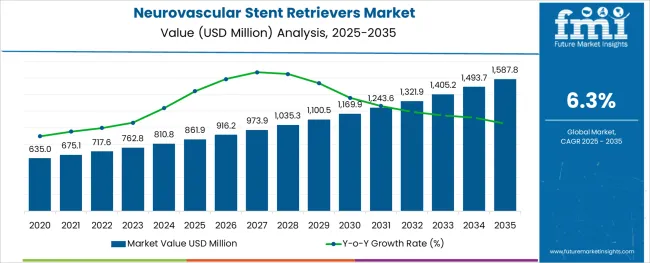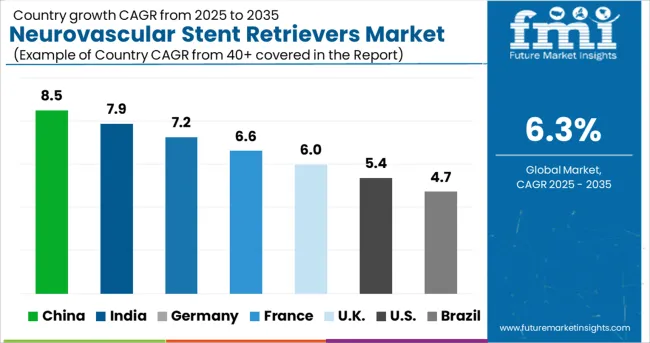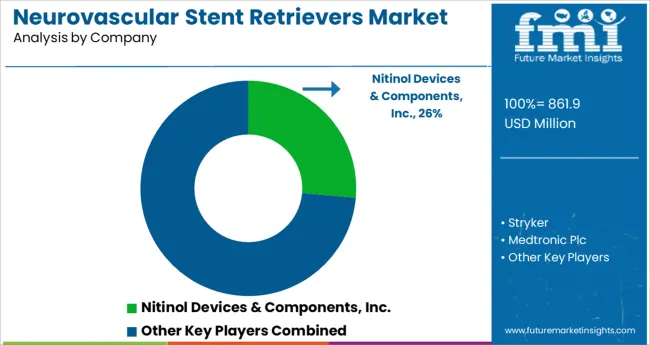The Neurovascular Stent Retrievers Market is estimated to be valued at USD 861.9 million in 2025 and is projected to reach USD 1587.8 million by 2035, registering a compound annual growth rate (CAGR) of 6.3% over the forecast period.

The alginic acid market is undergoing consistent growth, propelled by rising demand from food processing, pharmaceutical formulations, and cosmetic applications. A growing focus on natural and sustainable ingredients in manufacturing processes has positioned alginic acid as a preferred biopolymer across industries.
The market is further supported by its diverse functional benefits, including water retention, gelling, and stabilizing properties, which make it indispensable in high-performance formulations. Increased regulatory acceptance of alginates as safe additives and the push towards cleaner labeling in food and personal care products have reinforced their adoption.
Ongoing innovation in extraction technologies and the utilization of algae as a renewable resource are paving the way for cost-effective production and expanded applications, ensuring sustained market expansion in the coming years.
The market is segmented by Product, Material, and End Users and region. By Product, the market is divided into Balloon Expanding Stents and Self-Expanding Stents. In terms of Material, the market is classified into Metal, Stainless Steel, Nitinol, and Polymer. Based on End Users, the market is segmented into Hospitals, Ambulatory Surgical Centers, and Others. Regionally, the market is classified into North America, Latin America, Western Europe, Eastern Europe, Balkan & Baltic Countries, Russia & Belarus, Central Asia, East Asia, South Asia & Pacific, and the Middle East & Africa.
When segmented by salts, sodium alginate is expected to command 27.5% of the market revenue in 2025, marking it as the leading subsegment in this category. This leadership has been driven by its superior solubility, ease of incorporation into formulations, and versatility in a wide range of applications.
Its ability to form stable gels and maintain viscosity under varying conditions has made it highly sought after in both food and pharmaceutical sectors. Manufacturers have prioritized sodium alginate due to its consistent performance, cost-effectiveness, and regulatory acceptance, which have collectively strengthened its position.
The segment’s prominence has also been enhanced by its adaptability to evolving consumer preferences for plant-derived and sustainable ingredients, reinforcing its market share.
Segmented by end user industry, the food industry is projected to hold 33.0% of the market revenue in 2025, positioning it as the most prominent sector. This dominance has been shaped by the industry’s increasing reliance on alginic acid and its derivatives to deliver desirable textures, stabilize emulsions, and improve shelf life of processed foods.
As consumer demand for clean label and natural additives has intensified, the food sector has responded by integrating alginates into bakery, dairy, and confectionery products. Enhanced production efficiency and compliance with food safety standards have further encouraged widespread use.
The segment’s leadership has also been supported by product differentiation strategies where alginates contribute to premium quality and innovation, securing their role in modern food formulations.
Due to the use of neurovascular stent retrievers in the treatment of even the most serious cases of stroke caused by thromboembolic occlusion, the neurovascular stent retrievers market is expected to witness significant growth in the coming years.
According to the World Health Organization, approximately 5 million people are estimated to suffer from strokes worldwide every year. In the past few decades, obesity and diabetes have been on the rise in the world. These two diseases have been responsible for a rise in the prevalence of strokes and the development of neurovascular stent retrievers to meet the demand.
There is a growing demand for stent retrievers in the event of an acute embolic stroke, for the restoration of flow, and in the case of thrombectomies. Clinical tests and results are overflowing with favorable results in favor of the more innovative designs emerging in the global neurovascular stent retrievers market, as well as the effectiveness of these technologies in restoring blood flow swiftly and efficiently.
In addition to successfully retrieving clots from major intracranial arteries, the neurovascular stent retriever can also successfully remove clots from intracranial veins. This factor is sure to ensure that the market is growing at a steady rate.
Market growth is attributed to technological innovations and neurovascular stent retrieval advancements. Several governments around the world, especially those in developed countries, are encouraging the advancement of neurovascular stent retrievers.
Since the use of neurovascular stent retrievers has shown significant improvements in patients’ health, this has led to the governments supporting the use of these devices. Further, the sedentary lifestyle and unhealthy eating habits of people globally are also contributing to the growth of the global market for neurovascular stent retrievers.
The key factors for the promising growth of global neurovascular stent retrievers market are increasing corporate and government funding in research and development field, technological advancements, increasing number of patients undergoing stroke, enhancement in health facilities, rise in healthcare investments, growing requirement for minimally invasive surgery procedures and increasing change in lifestyle related diseases such as obesity which is the major cause of increasing stroke incidences..
The limitations in the growth of global neurovascular stent market are complexities of neurovascular surgeries and requirement of dwell time. The multiple passes of stent are needed in some patients in order to remove clot may result in occurring corresponding disorders. Due to the loss in access to occluded vessel high risk involved in the stent retrieving process.
With the rapid advancement in technology and increasing number of patients undergoing stroke and government initiative for research and development, the global neurovascular stent retrievers market is expected to expand at healthy CAGR during the forecast period (2020 to 2029). Based on product type, the neurovascular stent retrievers marketsegmented into, Balloon Expanding Stents and Self-Expanding Stents.
The balloon expanding stents are used widely hence they are expected to drive the market of neurovascular stent retrievers.

Depending on geographic region, global neurovascular stent retrievers market is segmented into seven key regions: North America, Latin America, Eastern Europe, Western Europe, Asia Pacific, Japan, and Middle East & Africa.
North America dominates the global market neurovascular stent retrievers followed by Europe, Japan and Asia Pacific owing to increasing ischemic stroke prevalence, advancement in technology and as in maximum stent retrievers are expected to enter market The developing nations in Asia Pacific, Middle East and Africa hold huge potential for growth in the global neurovascular stent retrievers market, due to adoption of new technology and development in healthcare infrastructure.

Some of the key participating global neurovascular stent retrievers market are Nitinol Devices & Components, Inc., Stryker, Medtronic Plc, STI Laser Industries, Ltd., Norman Noble, INC.,Hobbs Medical IN ,Akron Inc. Advent Devices Pvt. Ltd, Meril Life Science Pvt .Ltd. The manufacturers are focusing on investing in research and development in order to bring new and simple technologies to reduce stroke problems.
The research report presents a comprehensive assessment of the market and contains thoughtful insights, facts, historical data, and statistically supported and industry-validated market data.
It also contains projections using a suitable set of assumptions and methodologies. The research report provides analysis and information according to categories such as market segments, geographies, types, technology, material and applications.
The report is a compilation of first-hand information, qualitative and quantitative assessment by industry analysts, inputs from industry experts and industry participants across the value chain. The report provides in-depth analysis of parent market trends, macro-economic indicators and governing factors along with market attractiveness as per segments. The report also maps the qualitative impact of various market factors on market segments and geographies.
The global neurovascular stent retrievers market is estimated to be valued at USD 861.9 million in 2025.
It is projected to reach USD 1,587.8 million by 2035.
The market is expected to grow at a 6.3% CAGR between 2025 and 2035.
The key product types are balloon expanding stents and self-expanding stents.
metal segment is expected to dominate with a 41.7% industry share in 2025.






Our Research Products

The "Full Research Suite" delivers actionable market intel, deep dives on markets or technologies, so clients act faster, cut risk, and unlock growth.

The Leaderboard benchmarks and ranks top vendors, classifying them as Established Leaders, Leading Challengers, or Disruptors & Challengers.

Locates where complements amplify value and substitutes erode it, forecasting net impact by horizon

We deliver granular, decision-grade intel: market sizing, 5-year forecasts, pricing, adoption, usage, revenue, and operational KPIs—plus competitor tracking, regulation, and value chains—across 60 countries broadly.

Spot the shifts before they hit your P&L. We track inflection points, adoption curves, pricing moves, and ecosystem plays to show where demand is heading, why it is changing, and what to do next across high-growth markets and disruptive tech

Real-time reads of user behavior. We track shifting priorities, perceptions of today’s and next-gen services, and provider experience, then pace how fast tech moves from trial to adoption, blending buyer, consumer, and channel inputs with social signals (#WhySwitch, #UX).

Partner with our analyst team to build a custom report designed around your business priorities. From analysing market trends to assessing competitors or crafting bespoke datasets, we tailor insights to your needs.
Supplier Intelligence
Discovery & Profiling
Capacity & Footprint
Performance & Risk
Compliance & Governance
Commercial Readiness
Who Supplies Whom
Scorecards & Shortlists
Playbooks & Docs
Category Intelligence
Definition & Scope
Demand & Use Cases
Cost Drivers
Market Structure
Supply Chain Map
Trade & Policy
Operating Norms
Deliverables
Buyer Intelligence
Account Basics
Spend & Scope
Procurement Model
Vendor Requirements
Terms & Policies
Entry Strategy
Pain Points & Triggers
Outputs
Pricing Analysis
Benchmarks
Trends
Should-Cost
Indexation
Landed Cost
Commercial Terms
Deliverables
Brand Analysis
Positioning & Value Prop
Share & Presence
Customer Evidence
Go-to-Market
Digital & Reputation
Compliance & Trust
KPIs & Gaps
Outputs
Full Research Suite comprises of:
Market outlook & trends analysis
Interviews & case studies
Strategic recommendations
Vendor profiles & capabilities analysis
5-year forecasts
8 regions and 60+ country-level data splits
Market segment data splits
12 months of continuous data updates
DELIVERED AS:
PDF EXCEL ONLINE
Neurovascular Device Market Size and Share Forecast Outlook 2025 to 2035
Neurovascular Guidewires Market Insights – Growth & Forecast 2025-2035
Neurovascular Access Catheters Market
Stent Delivery Systems Market Size and Share Forecast Outlook 2025 to 2035
Stent Graft Balloon Catheter Market Insights - Growth & Forecast 2025 to 2035
Existent Gum Steam Generator Market
Gel Stent Market Size and Share Forecast Outlook 2025 to 2035
Persistent Epithelial Defect Management Market Size and Share Forecast Outlook 2025 to 2035
Venous Stents Market Size and Share Forecast Outlook 2025 to 2035
Aortic Stent Grafts Market Analysis - Size, Share, and Forecast 2025 to 2035
Enteral Stents Market
Ureteral Stent Market Size and Share Forecast Outlook 2025 to 2035
Branched Stent Graft Market Size and Share Forecast Outlook 2025 to 2035
Coronary Stents Market Insights – Trends, Growth & Forecast 2025-2035
Nephrology Stents and Catheters Market
Non-Vascular Stents Market Growth - Trends & Forecast 2025 to 2035
Bioabsorbable Stents Market Growth – Trends & Forecast 2025 to 2035
Advanced Persistent Threat Protection Market
Nephroureteral Stent Market Size and Share Forecast Outlook 2025 to 2035
Gastrointestinal Stent Market Growth - Trends & Forecast 2025 to 2035

Thank you!
You will receive an email from our Business Development Manager. Please be sure to check your SPAM/JUNK folder too.
Chat With
MaRIA